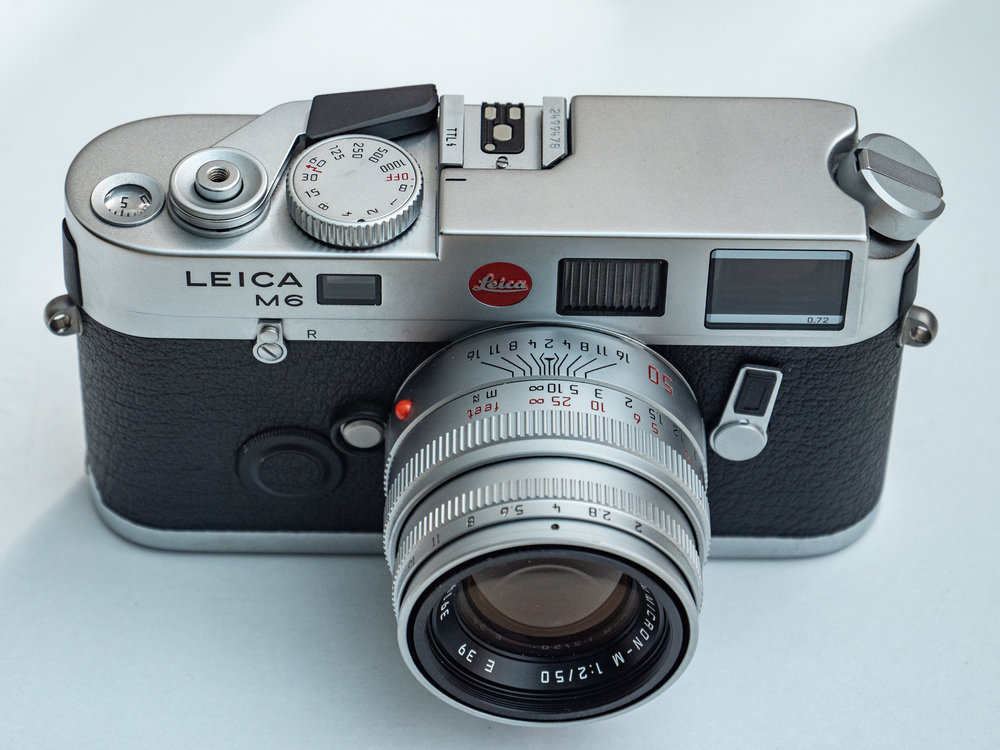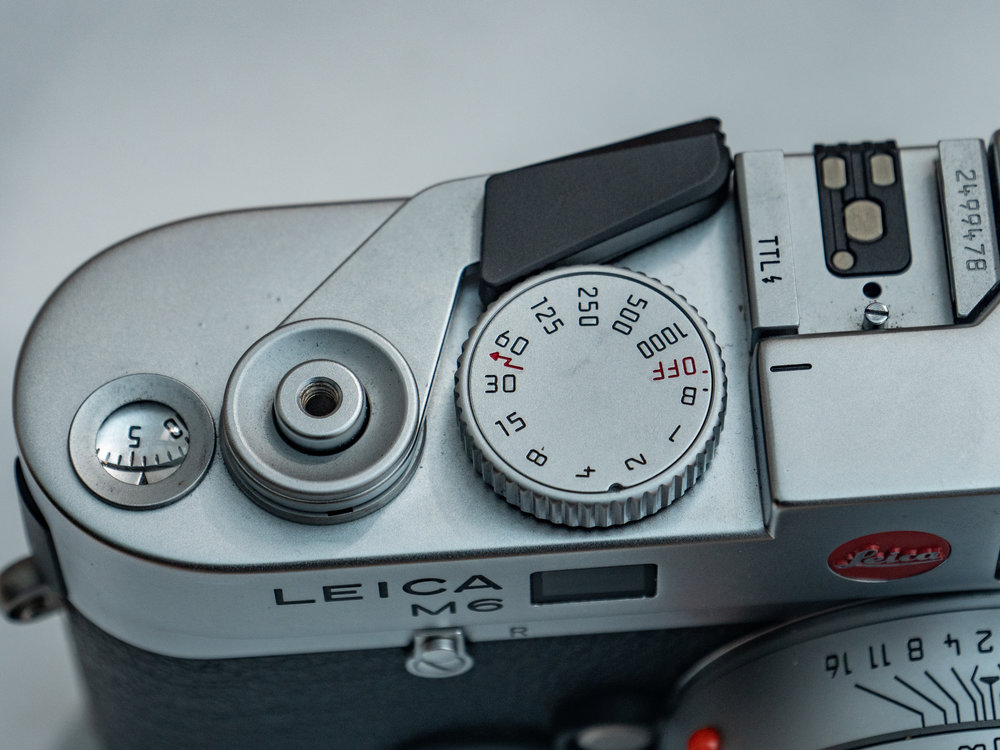
Film’s not dead. This is shaping up to be the theme for this week. And Leica is definitely the foremost proponent of the modern film camera. There are no fewer than three models in the current range, the M-A, MP and M7, to choose from. All offer a different shooting experience although the M-A, which harks back to the simple days of the original M3, is a totally manual device without light metering. The MP uses manual exposure settings, identical to the M6 classic, whereas the M7 incorporates automatic aperture-priority shooting.
If you are in the market for a used Leica with metering, however, it’s a pretty clear choice between the M6 and M7. The MP is highly desirable on the used market and I’d rule it out on price alone. It is inevitably more expensive than either the M6 or M7 and is one for the collectors. As a new buy, though, the MP is actually the better choice because depreciation is lower than on the M7.
M7 and M6
The M7, which represents the pinnacle of Leica’s film camera development, operates to all intents and purposes in the same way as the M digitals, including the current M10. It is, in effect, a film version of the M10 and offers the same system of automatic aperture-priority exposure. Set the speed dial to auto and all you then have to do is adjust the aperture and the speed will be calculated to suit.

By rights, then, the M7 should be the natural choice for the film enthusiast. But it isn’t always so. It’s the earlier M6, particularly the “classic” original, that appears to set the film photographers’ pulses racing. For some reason that I have never understood, the M7 is underrated and the price is a reflection of this. A good used example can be bought for £1,400-£1,500 which is as little as £300 more than a similar M6 classic.
To my mind this makes the M7 a colossal bargain on the used market, but — using the same logic — not such a bargain when bought new for £3,700 because it will lose its value more rapidly. Either of the two other current models, the MP and the M-A, would be a better long-term bet in terms of value retention. But at under £1,500 the M7 is a great used camera choice and makes a terrific complement to the M10 in use. The controls are identical and you hardly realise that one is digital, the other film.


The M6 TTL shutter speed dial (left) is larger than that of earlier cameras such as the M6 classic and the current MP. Note the OFF position to conserve batteries. The M7 (right) has a similar layout to the current digitals, including the M10, with an on/off switch concentric with the shutter release. The dial features an Auto setting, just like the M10, to allow automatic aperture-priority shooting. Note the line next to 1/60s and 1/125s which indicates that these two speeds can be used mechanically in the event of battery failure
M6 TTL
The M6 TTL is the version of the M6 I own. It’s the more recent model and its major benefit, from my perspective, is the larger shutter speed dial which is similar in size to that of the M7. It is definitely easier to use and it has another advantage in that the direction of movement is reversed so that it follows the direction arrows in the viewfinder when adjusting speed to match the exposure.
Because of this, the TTL offers a more direct comparison with the M7 in terms of controls and it is the TTL that would be my choice from the M6 era. The M7 just adds to the M6 TTL with its auto speed setting facility. Both the M6 TTL and the M7 carry very similar prices on the used market and you should be able to pick up a good version of either for around £1,500.
However, since the M7’s shutter is dependent on batteries, with only two speeds (1/60s and 1/125s) available mechanically if the batteries should fail. Some see this as a disadvantage and, undoubtedly, it is one of the reasons the M7 is less popular than the M6 or MP. Another is that the M7 has a reputation for eating those batteries, although it hasn’t been a problem for me. However, the two 3v 1/3N cells are not expensive and it’s an easy matter to keep a couple of spares in your pocket.
I don’t worry about this and the auto aperture priority shooting is sufficient compensation for the small additional cost and inconvenience. I definitely appreciate the ability to use the camera on auto in the same way that I mostly use the M10. In fact, if you carry both cameras, switching between one and the other is seamless.
While I can fully understand the lure of the more traditional M6, M6TTL and MP, the M7 offers a lot of camera for the price and should definitely be on your shopping list.
Finally, with all this talk of Leica film cameras, it’s clear that they command a premium but they do tend to be a good investment. If you’d bought an M6 or M7 just three years ago you would make a profit if you sold now. So, despite the upfront cost, the appreciation in these models will help pay your film bill. However, none of this disguises the fact that there are thousands of excellent film cameras out there that will cost you relatively little. For as little as £50 you can be up and running with a Pentax or Olympus (including a good prime lens) and will get just as much enjoyment as you could from a Leica.
Leica Rumors pointed me in the direction of this informative video by Nate Matos which talks us through the relative merits of the M6 (classic) and its successor, the M7. If you are in the market for a light-metered camera (as opposed to the M3, M2 and M4 unmetered models), then this video is a good start. Below is another entertaining look at two Leica cameras, this time the M10 and the M6 by bloggers George Muncey and Joe Greer

I’ve had my M7 for almost 3 years now and I haven’t had to change the batteries yet. I’ve put about 50 rolls of film through the camera in that time.
My M10 on the other hand only gets about a day of shooting on a battery.
Subjectively, the battery problem is most noticeable if the camera is not used for a time. I use my M7 sparingly and I have found battery problems. If, as in your case, you are using it all the time the batteries seem to last longer. Strange.
I have been using mine extensively. every day. it ate so many batteries that I sold it, because I used to run out on trails & travels. seems to be different with different cameras… I liked the M7 most of all leicas. looking at the price of the cameras it seems best tu buy a ltd edition of some titanium mechanical camera, not unpack it & sell it 10 years later. meanwhile I use medium format. even the best 35mm lens can’t match MF quality. there are super cheap 4×45 by fuji, for some more money on can get 67 which is amazing even by digital standards.
I too like the M7. To reverse an analogy, it is a digital M without a sensor. Works in exactly the same way and is a painless transition to film for, say, an M11 ussr. But you are right in the battery issue. The new M6 is probably the sweet spot for a new film camera. I am not one to buy a limited edition and put it on the shelf for ten years. Better to buy a series camera and use it!
For me, the best film M was the M3. I have all of the film Ms up to and including the M7 except for the M6TTL. I prefer the M6 to the M7 as it seems smaller and nicer in the hand, but, for me, the viewfinder in the M3 trumps all others. It is all about personal preferences, of course.
I have seen some rangefinder flare in some models, but nothing that would bother me. I have not seen any in the wonderful M3 viewfinder.
William
I have an M-A with a light meter. Mine only cost £850 and is just like new. I think this is because they wrote M2 on the top instead of M-A.
Yes, you are right. I’ve had good relationships with the M2 as well as the M3 and M4 (but not the M5 which I have not had the pleasure of trying). As you realise, however, this article was looking at M cameras with built-in light metering which some people do prefer. But enjoy the M2, it is probably a more sensible buy than the M-A.
I am very well aware that the aforementioned issues exist, but my experiences differ somewhat.
E.g. I never had a (digital) M-camera for a simple clean- and adjust-job more than two weeks in the hands of Leica customer care (and I did that fairly often over the years, with M9, M240 or M10). But maybe that’s a kind of home-advantage, being on German soil.
Then – call it luck – no sensor flare at all (that I’m aware of). And btw, I enjoy shooting my M6 parallel to my M10 just as well. Even if I have to set shutter speed manually on the M6 it’s very much the same ergonomics. Let’s forget about the fact that occasionally I search for the monitor on a very bland backside of the M6 and/or for the film advance lever on the M10…
Remember, real value is in the joy found in using your tools, not in the resale value. My key issue with Leica is the glacial speed of repair or adjustment of rangefinder. However, after taking 6 months to adjust my rangefinder and professionally clean the sensor on my out of warranty M, they sent it back from Germany with no charge – I was delighted except for being rangefinder less for 6 months. Hence, to enjoy Leica, you need deep enough pockets for a secondary camera.
Both yours and Wayne’s points are well made. For sheer pleasure and economy, an old OM-1 would do just as well. I don’t do a lot of film, partly because I am too lazy to do my own processing, but mainly because everything I take tends to be time-sensitive — needing to get it on the blog as soon as possible. But I would really like to spend more time shooting the M7, M6 and the others.
One aspect of M7, and even certain M6TTL cameras that should be first and foremost in the used camera buyers mind is RF flare. I have owned the M7 and now own an M6TTL. Both cameras have displayed the much discussed problems associated with flare. It is not a problem to be given short shrift. I suppose both of my cameras were examples displaying the highest degree of this problem, to the point where, in certain circumstances, accurate focus was virtually impossible. In no instances was the flare a complete non-issue. I write this not to disparage Leica, but rather, to make those considering one of these cameras aware that this problem is not just a minor inconvenience…..It is a problem truly impacting enjoyment of the cameras. As I understand it, not all examples of these models are as seriously afflicted as others. If you consider the purchase of a camera that is known to have this issue, make sure it is discounted at least as much as Leica will charge you to upgrade the VF/RF.
I definitely concur. I shoot both an M7 and M10, and it helps immensely that they share lenses and virtually identical ergonomics. Tellingly, the M7 gets used far More than the M10.
However, I struggle to see the M7 as an investment – or any other Leica camera that you use extensively. Mine was practically like new when bought, but after four years of heavy use, the black chrome is wearing and the shutter curtain has been patched with liquid rubber. When you add in the soon to be unavoidable cost of even a non-Leica overhaul, it is terrible value.
But despite the cost and relative fragility, the M7 is by far the best and most enjoyable film camera system that I have used. There are obviously cheaper film systems around (I also sometimes shoot Minolta SLRs), but for street or documentary photography M series film cameras are hard to beat.
You could be right on the investment front. It’s just that you can have a lot of fun without much, if any, depreciation — all other issues set aside.